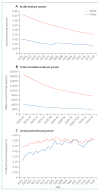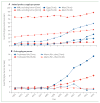Food supply and food safety issues in China
- PMID: 23746904
- PMCID: PMC3888022
- DOI: 10.1016/S0140-6736(13)60776-X
Food supply and food safety issues in China
Abstract
Food supply and food safety are major global public health issues, and are particularly important in heavily populated countries such as China. Rapid industrialisation and modernisation in China are having profound effects on food supply and food safety. In this Review, we identified important factors limiting agricultural production in China, including conversion of agricultural land to other uses, freshwater deficits, and soil quality issues. Additionally, increased demand for some agricultural products is examined, particularly those needed to satisfy the increased consumption of animal products in the Chinese diet, which threatens to drive production towards crops used as animal feed. Major sources of food poisoning in China include pathogenic microorganisms, toxic animals and plants entering the food supply, and chemical contamination. Meanwhile, two growing food safety issues are illegal additives and contamination of the food supply by toxic industrial waste. China's connections to global agricultural markets are also having important effects on food supply and food safety within the country. Although the Chinese Government has shown determination to reform laws, establish monitoring systems, and strengthen food safety regulation, weak links in implementation remain.
Copyright © 2013 Elsevier Ltd. All rights reserved.
Conflict of interest statement
We declare that that we have no conflicts of interest.
Figures



References
-
- UN Department of Economic and Social Affairs. World population prospects: the 2010 revision, highlights and advance tables. New York, NY: United Nations; 2011.
-
- Campbell TC, Campbell TM., II . The China study. Dallas, TX: Benbella Books; 2006.
-
- Kantha SS. Nutrition and health in China, 1949 to 1989. Prog Food Nutr Sci. 1990;14:93–137. - PubMed
-
- Peng X. Demographic consequences of the Great Leap Forward in China’s Provinces. Popul Dev Rev. 1987;13:639–70.
Publication types
MeSH terms
Grants and funding
LinkOut - more resources
Full Text Sources
Other Literature Sources
Medical

